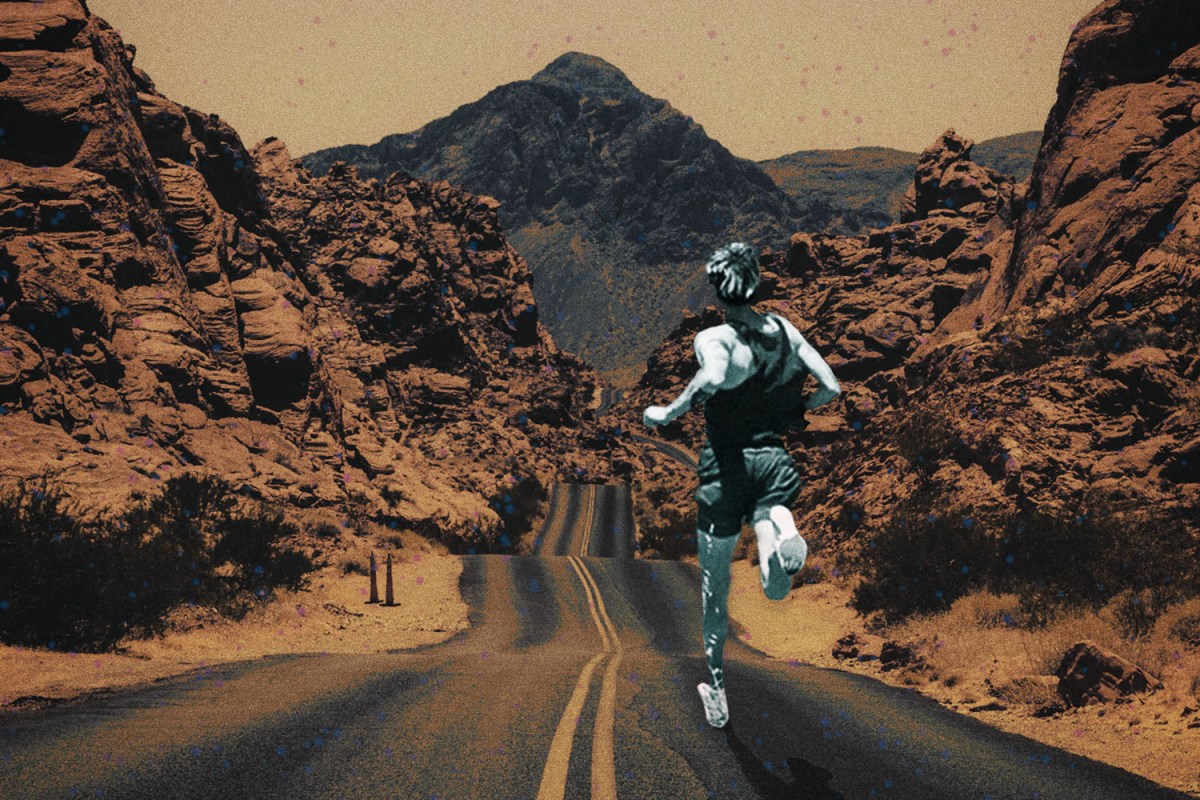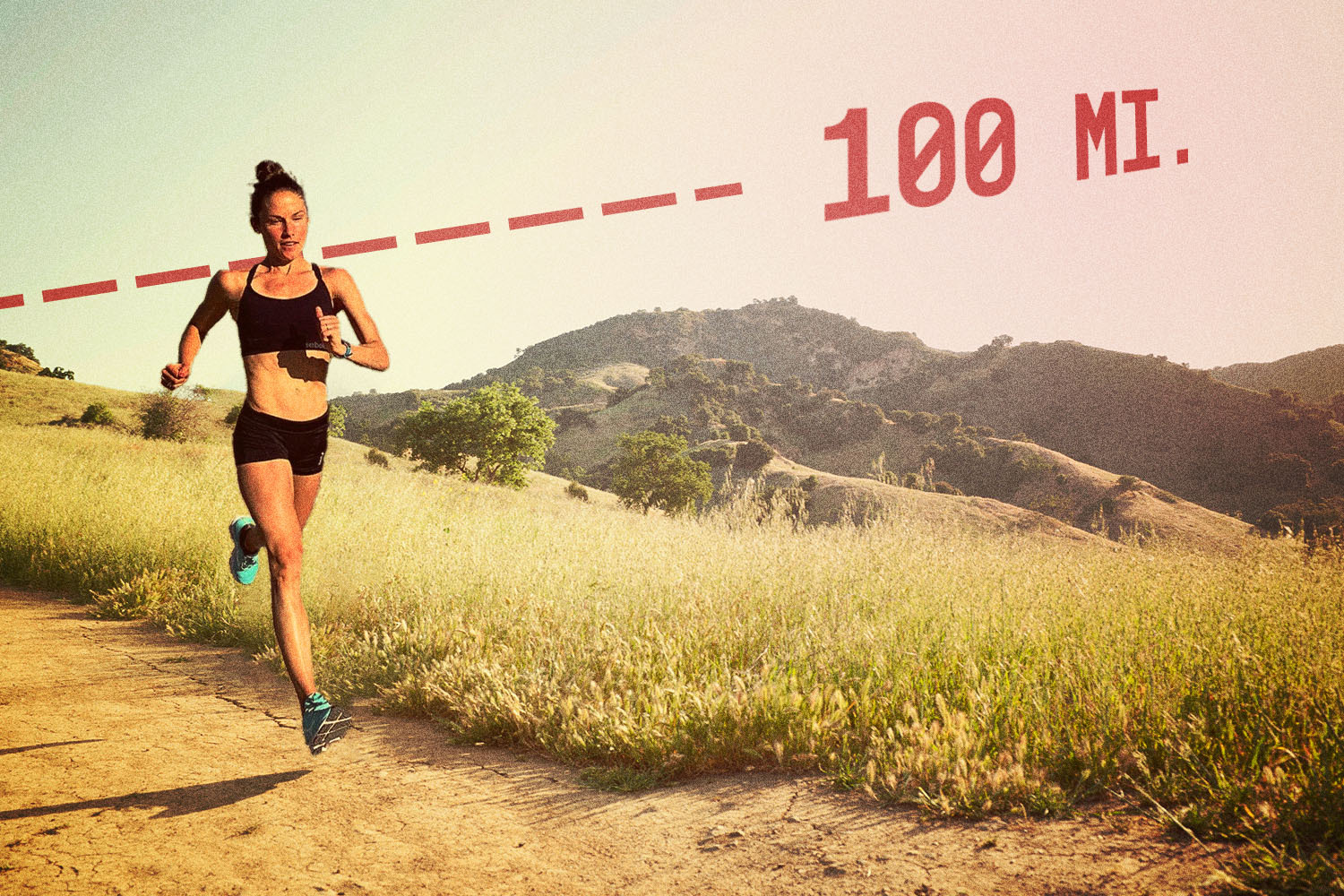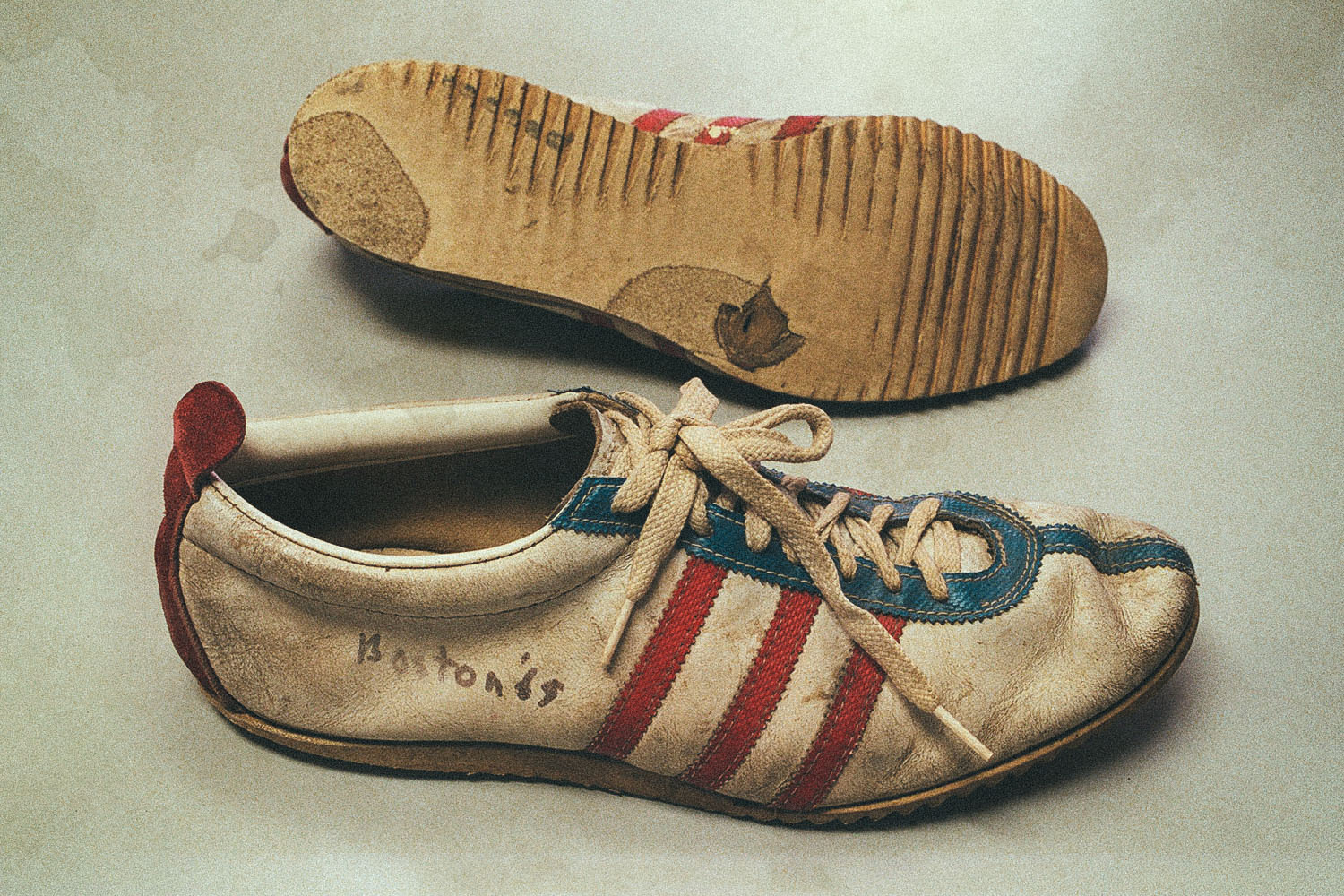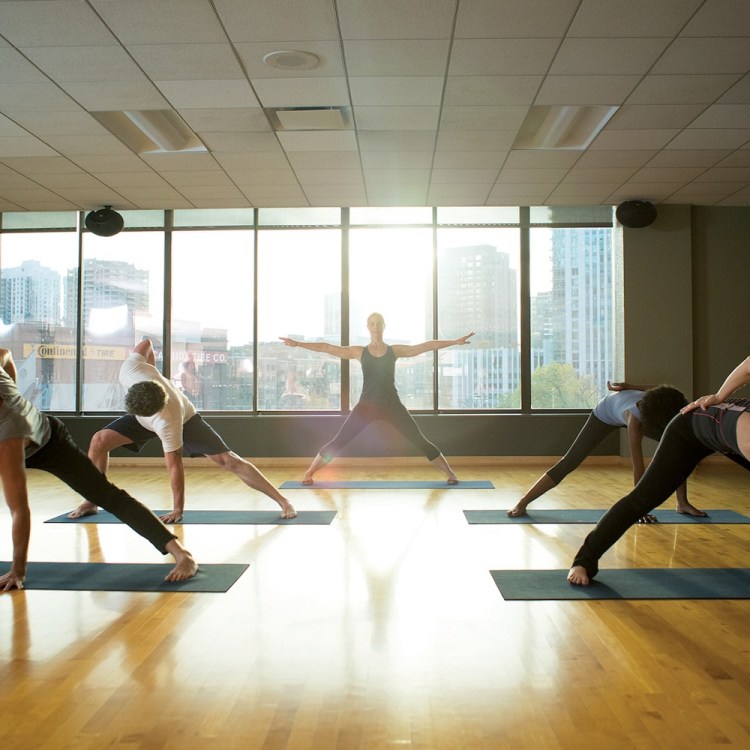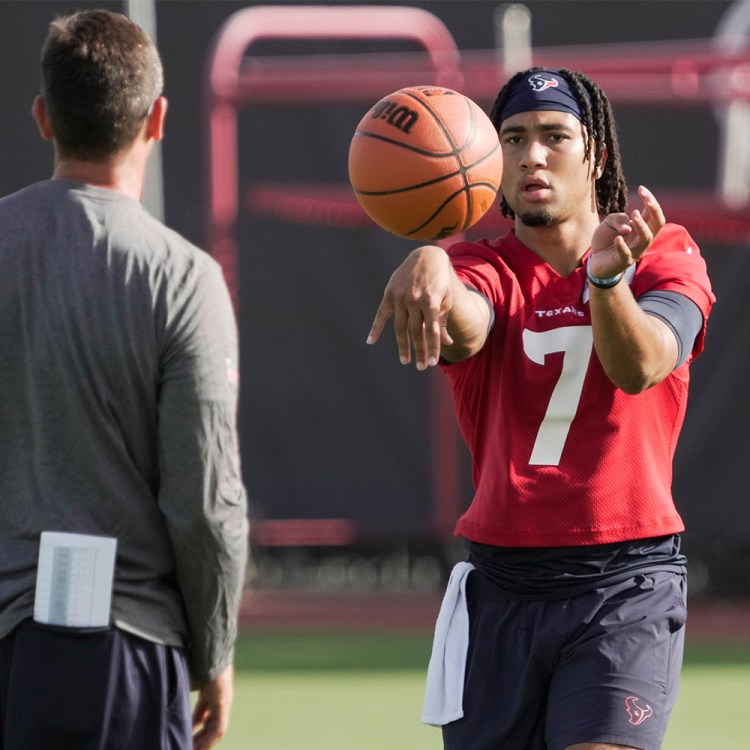The runners are relieving themselves, gracing the bone-dry bushes 20 miles south of Tecopa, California, with coconut-water-colored urine. They don’t bother going more than five feet into the desert. It’s empty here, but that hardly makes a difference to them. Earlier, one of the runners had politely greeted an early-rising grandma while taking a shit on the front lawn of an office park wedged between a Filipino church and a firefighter’s credit union. Mission over modesty, it was decided, right at the very beginning.
That mission? The Speed Project, an unsanctioned, underground 350-mile relay race through San Bernardino County, from the Santa Monica Pier to the “Welcome to Fabulous Las Vegas” sign. There are six runners on the team I’m covering; they’re racing against 20 other teams, and from dawn on Friday to nightfall on Saturday, each one will be responsible for covering the equivalent of two marathons — on minimal food and practically zero sleep — through one of the hottest regions on the planet.
Running isn’t a contact sport. You wouldn’t call it an extreme sport, either. In fact, much like cyclers, surfers and climbers, some runners seem intent on divorcing the sport from simple labels or identifiers altogether. It’s not that they’re indifferent to its traditions and boundaries — they just find themselves caged, restless, desperate to do something else, something more. What’s the point of chasing another PR in a 5K or marathon? What does a time mean, if it’s been run on the track (perhaps that very track, on that very night) thousands of times before? Once a runner’s attention shifts away from record books and measurability, who’s to say what a race should even look or feel like?
A tiny yet mighty portion of the running community think they have the answer. They’re nudging the sport into the survival space; runners may never have to weather tackles, punches or serious collisions, but events like The Speed Project treat running as a kind of trial in human perseverance, an opportunity to test the limits of one’s body and mettle. They tend to either exceed expectations or collapse trying.
Any movement like this one needs a proverbial devil on its shoulder. In Los Angeles, that’s Nils Arend, an old-school ideas guy who was throwing parties in a Hamburg brothel before migrating to Southern California in the mid-aughts with imperfect English and just enough cash to rent a Craigslist-sourced apartment. Before long, he’d built a multi-national creative marketing agency with more than 100 employees and a circle of artist and surfer friends he’d meet up with on the weekends. They were men and women about town in the most literal sense: Nils and his friends began running distances of 35 miles in a single day. From the water to the Hollywood sign. From Long Beach to Manhattan Beach. They’d hide handles of vodka along the routes and make sure to finish at a house stocked with cold beer. Nils had never been a competitive runner, but suddenly he was talented enough to make the podium at the Malibu Marathon, and it hadn’t come at the expense of his improvisational lifestyle.
This is The Speed Project’s Old Testament. In 2013, the very first year, it wasn’t a race at all. It was a pact among people who didn’t need to be convinced to do something. They made a documentary — at the time, the internet didn’t really care — which included a fascinating quote from one of Nils’s teammates, Shawn Waco: “A lot of runners are crazy. But the hardest part is getting six runners crazy enough to do this. Could they do it? Yeah. But will they? Would they?”
As it turns out, they would. Nearly a decade later, The Speed Project still doesn’t have a website or an application form. It hasn’t even occurred annually, most recently due to the pandemic. But hundreds of runners try to get in every year. Crucially, Nils and Associates don’t grant entry based on time standards. Some of the fastest people in the world are turned away. Drawing on his nightclub roots, Nils curates a guest list of fewer than 30 teams with an aspirational “no assholes” policy: that doesn’t mean it’s a neighborhood Turkey Trot — anyone can run — but rather that Nils needs to know your motivations. He’s looking for good people with even better stories.
I spent two days this past summer with a team of long-distance mercenaries assembled by French running outfitter Satisfy as they high-tailed it through the high desert, from Los Angeles through the suburbs of San Bernardino to a stretch where you’re more likely to happen upon trails cut by Spanish explorers than paved highways. Though the team came in with every intention of winning and ran objectively well (at one point they seemed destined for a top-three finish), they ended up in a distant 12th place out of 20-plus teams. What went wrong? RV failure, knee injuries, broken AC units, extreme dehydration and a mining town called Shoshone, among other things. From another, twisted perspective, though — that of an always-evolving race with no course map or sure things — you might say everything went exactly according to plan. It’s why, when they finally popped Champagne on the Strip, 40 hours after departing Ocean Avenue, there was no regret in the runners’ faces. Only gratitude.

They haven’t had it easy. They are the children of divorce, foreclosures, racism, sexual abuse, gangs. They have struggled with addiction. They tell me: “When the world ends, it’ll be me, Keith Richards and the cockroaches.” They remember life feeling like a movie, but it wasn’t a zippy romcom, it was a psychological thriller. They’ve quit things; they’ve quit on themselves. They don’t talk to their families, or they FaceTime them constantly. They are from Seattle, St. Louis, Pasadena, Charlotte, the Upper West Side, Bed-Stuy. They are certified yogis and certified hairdressers. One is the son of Alex Van Halen, another has been on the cover of Elle. They each came to running in their own ways: as off-season training for an AAU circuit that included Kyrie Irving, as a spiritual reset after a decade spent battling alcoholism, as a full-ride ticket to a Division 1 school. At times, in the desert, this stuff is utterly irrelevant. At other times, it matters a lot.
When a team enters The Speed Project, it has a choice: OG or freestyle. OG is the race as it was first run, and as it is intended: six athletes, four men and two women, running in intervals from Los Angeles to Las Vegas. Teams can enter with up to 10 runners, but their finish won’t count in the official rankings or record book. And really, those extra spots in the RV are better given to a capable crew. This isn’t lip service — the crew is just as important as the runners. Not just to run fast, but to make it to the Strip at all. Ours includes Remi-Alade Chester, a Nigerian model you’d recognize from the Buck Mason or Marine Layer catalogues, and Hakim Tafari, a vegan-yogi-social-justice-warrior from London. The entire team is sponsored by Satisfy, the Paris-based brand that’s been busy chipping away at running’s “skinny white guy in prep stripes” reputation for years now, with technical gear that could be confused for streetwear. The runners wear black sweatshirts that say “Running Cult Member” and orange hats that read “California’s For Runners” or “Death Valley Cross Country ’89.”
In the runners, the gear and the crew, Satisfy’s mandate is obvious: Seek out stories. But they’ve also assembled a team of guerrilla-glam immortals with Bourdain energy. It’s an ambitious play. Bringing that many strong personalities together could backfire in any situation, but especially in confined quarters over the course of a sleepless adventure in which vehicular failure is likely and state troopers are never more than a few mile markers away. Over the weekend, there are two mobile HQs, and both are tight. There’s the Mercedes Sprinter, where all the running action takes place, and the bus, a coach from the early ’70s that normally tours bands this time of the year. The bus has a couch and a few chairs. You have to walk through the bathroom to get to the bed in the back. This is the locker room, the trainer’s room and the kitchen rolled into one. The athletes spend four-hour shifts here, during which they get rubbed down by a personal trainer from West Hollywood named Nirja Gajjar, take turns cocooning their calves in NormaTec sleeves, attempt to sleep, and snack on a variety of foods: full sweet potatoes in metallic astronaut pouches, Bagel Bites, Uncrustables, rice with smashed avocado, bananas, Snickers.
The Speed Project can be considered, to invoke Henry James, a “large, loose, baggy monster.” It expands and contracts at the whims of its participants. It invites invention. There are no rules, other than don’t break the law. So: no crime, and no running on the freeway (the surest way for a runner to be struck by a truck, or for the authorities to shut a team’s campaign down). A team’s course map is its own, as is its interval strategy. Over 45 hours, it’s highly unlikely a team will cross paths with another. This yields two prevailing consequences: while it’s happening, it’s possible to forget that The Speed Project is a race, and afterward, it’s impossible for a participant, journalist or photographer to paint any kind of consistent picture of what The Speed Project even is.
When Nils’s team first completed The Speed Project, they divvied up the desert into 10-kilometer sections. Six miles and change, then pass the baton. For a while, that was the conventional wisdom: eat up a good amount of road over a familiar distance then hand off to the next person. Take your three- to four-hour break as each of your five teammates repeats that same mileage. But then an enterprising European team arrived and shocked the world with an approach ripped straight from the Fields of Punishment: 90-second intervals, on and off, on an endless loop. A never-ending track workout from California to Nevada.
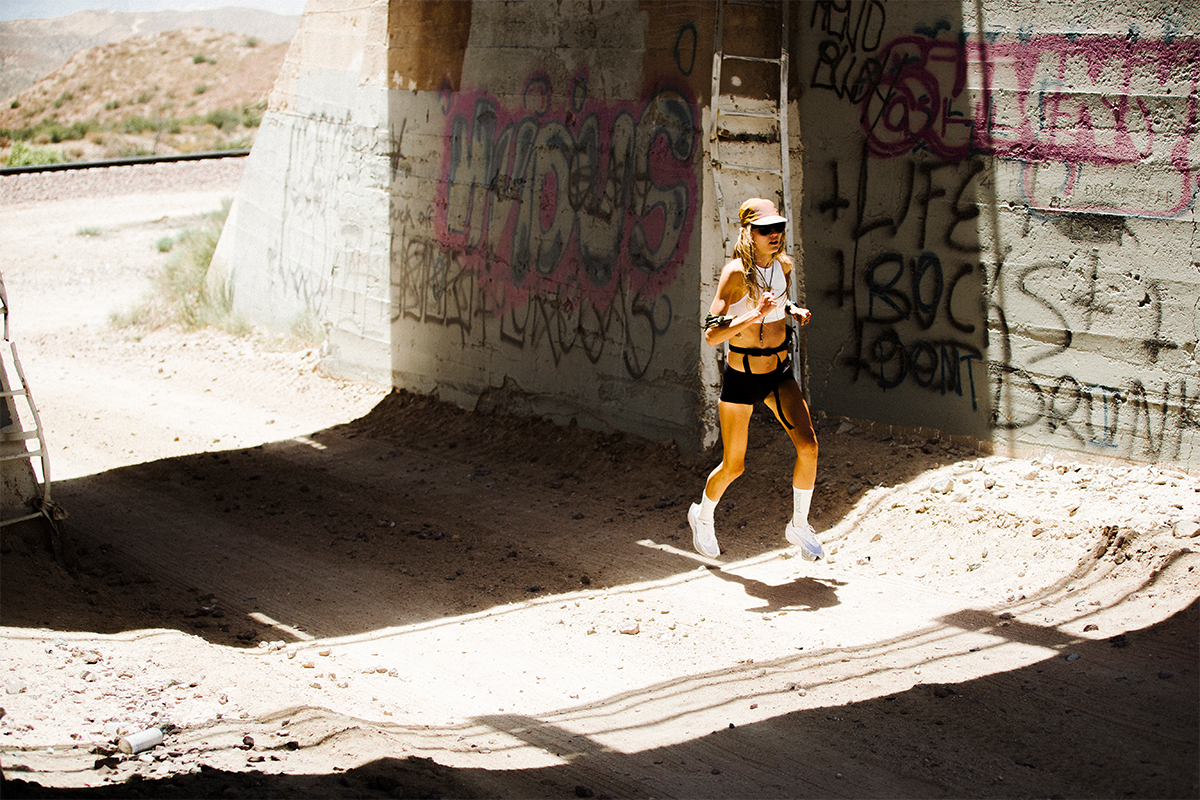
Lucie Beatrix swears she’s seen an alien. Multiple aliens, actually. She was out in the bush, recording an Instagram Story, when something nearby cackled. She plays the video for the bus. I groan. I’m ready to believe anything. The air conditioning stopped working a bit north of San Bernardino, so the windows are open. I listen for a rustle, a howl. I’ve been sleeping on the wooden floorboards in the kitchenette, my knees pressed against a case of waters to make sure a pesky drawer under the sink stays closed. I kick off some spare socks and sweatpants barnacled around my legs. It’s the middle of the night, but I can see a bit into the desert. The moon illuminates the sand like a backyard after a good snow. There are animals out there — coyotes, jack rabbits, bobcats, kangaroo rats — but I only see a couple miles of sand and stars. There’s no treeline to block the constellations. It’s easy to imagine the hysteria of life out here after the highways were built, why grown men and women were so quick to call their radio stations to report a peculiar sight or sound. During daylight, the kitschy Area 51 billboards and roadside paraphernalia are a welcome distraction from the heat, the boredom and the pain in our legs. Right now, in a quiet caravan on the side of the road, it feels like we’re waiting for an ambush.
Santa Monica was a decade ago, everyone agrees. It must’ve resembled a flash mob, or a joyful protest, when all the RVs lined up on Ocean Ave. A few dawn-shift cops could only watch on in disbelief as some hundred-odd runners and crew-members danced around, ate croissants, vomited in bushes and lit sage. Since the gun went off, we’ve made it through the mess of L.A.’s outer solar system — filthy rivers; Downtown Pasadena with its sushi shops and movie marquees; half-highways where Jack in the Box and Del Taco alternate on a warped loop. When we make it to San Bernardino County, the last county before Nevada, someone points out that it’s the largest in the entire country. It’s true, by almost 2,000 square miles (Alaska is divided into boroughs), and it’s a fitting factoid for the reality ahead, that it will take forever to feel anywhere close to Las Vegas. There’s the mileage, obviously, but also those “Oh, fuck” moments that lie in wait, the ones we’re expecting. They make the whole trip feel a bit deterministic, a bit doomed, like we’re on one of the earliest rocket ships, charting our way into the exosphere.
One such moment almost transpires earlier, on a power-line road in the middle of the Mojave. After a day of darting through dangerous intersections (the runners get livid when they get hung up at a red light), we’re finally in the middle of nothing, eager to stretch our legs. The sun is setting, the sky’s purple. There is enough of a breeze that some of the crew has trouble lighting a blunt. I’d officially started running back around Rancho Cucamonga, taking here-and-there shifts with Satisfy’s Team B, which chooses to run in 10-minute intervals. Team A, the crew informs me, has been running three minutes at a time, with some members of that group using the shorter distance to touch a 5:15 mile pace or better on their stints. Fortunately for me, the pace is closer to 6:00 per mile with Team B. Halfway through our progress in the actual desert, the Sprinter van faces a tricky hill. The back left tire gets stuck in the slip-rock. One of the runners, Thai Richards, is a half-mile ahead of us, waiting for the camper to catch up so he can rest. Remi orders everyone out of the car and engages four-wheel drive. He reverses down the hill, then charges back up it at 60 miles an hour. The Sprinter makes it to the top, then falters — as if in shock about what it’s just done — and threatens to teeter straight off the cliff. Finally, it rights itself. Remi flashes us a thumbs-up. We cheer like a little league baseball team.
We’ve heard rumors of other team’s RVs breaking down on trails elsewhere in the race. But we’re moving again. And while the vehicle complains for a bit, wheezing for a mile or so before finally switching back out of 4WD, it feels like we’ve passed our biggest test. The rental company won’t have to come rescue a forsaken van from the heart of the Inland Empire after all. Thai is replaced, we run well into nightfall, and the crew gets in touch with the tour bus for our next rendezvous point. It’s time to sleep. The last time any of the runners slept more than five hours at a time was Wednesday night. We’re now only a few hours from Saturday. But there’s another problem. Memorial Day Weekend traffic is so bad on Interstate 15 that cars have taken to traveling via our route, the parallel, 120-year-old Yermo Road, and it backs up almost immediately. We manage to swap one group of runners for the more rested trio, but retire knowing that the RV, just like the bus, is stuck. It could take several hours for the traffic to clear, and neither vehicle will be able to follow the runners. The runners need to figure out a way to keep their relay going — ideally with just one of them running at a time — in the middle of the night, without any external support. They head into the abyss.
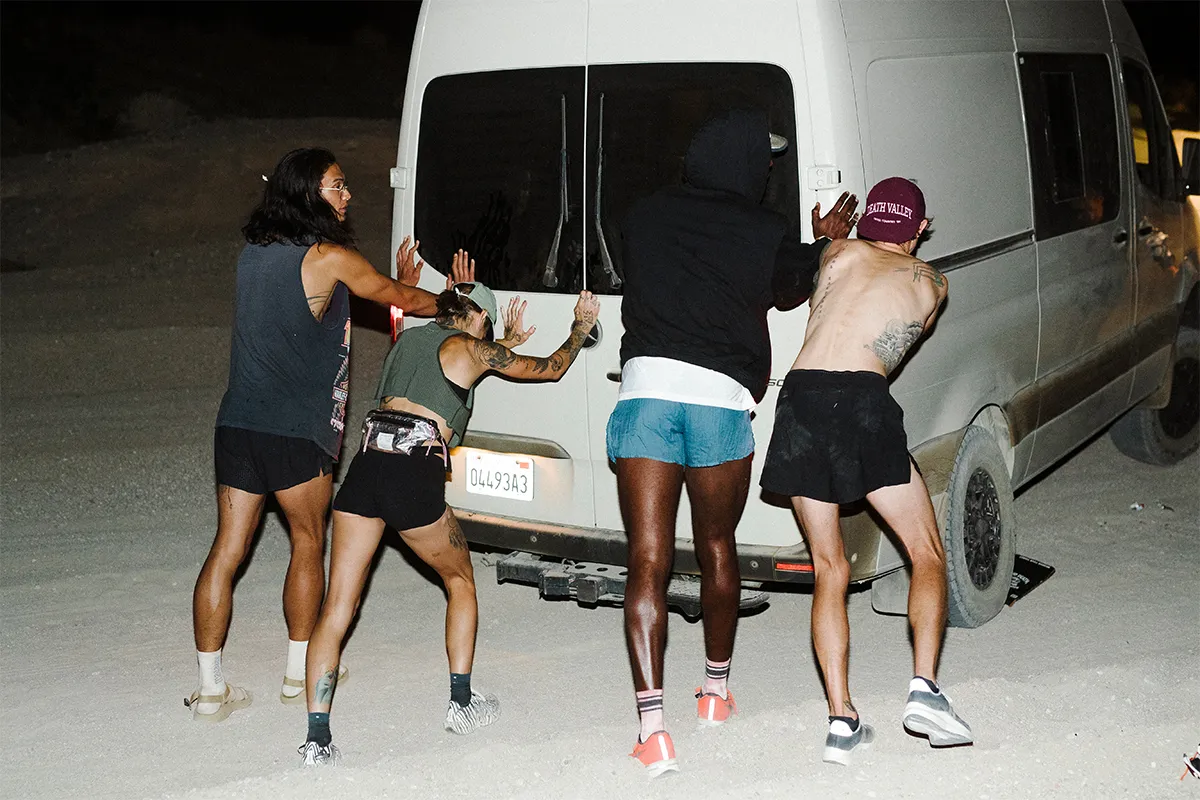
You’re allowed to wonder why people do this. It’s a question I pose often throughout the weekend, sometimes to the same person more than once. I’m hoping for a convenient, concise answer. There’s a theory there for the taking, especially whenever one of the runners casually alludes to some life-upheaving incident: sleeping in a car senior year of high school, escaping a violent partner, mourning a murdered father at the age of three. Running is recovery, right? It’s an opportunity to process pain by embracing a different version of it. But this idea is rejected, gently, multiple times. They shake their heads. Running itself isn’t painful to these people. In part, that’s why they’re so good at it. They don’t need to use memories as mental fuel. While out on the roads, they aren’t thinking about all the times life screwed them over. They aren’t thinking about anything. It’s a concept writers like Alex Hutchinson have investigated at length: the ability of elite endurance athletes to shut their brains off, to ignore everything, even cries from their bodies’ command centers, as oxygen levels dip, lactic acid builds and core temperatures soar.
There’s another reason they don’t question their role in this twisted physical experiment. An event like The Speed Project actually isn’t that outlandish anymore. The photographer who Satisfy hires for the job, Salt Lake City-based Moe Lauchert, tells me that a few weeks ago — the assignment just before his time embedded with anti-poaching rangers in South Africa — he shot mountaineer Michael Versteeg as he ran Cocodona, a five-day, “250ish”-mile footrace throughout the most treacherous trails of central and northern Arizona. Versteeg’s recent racing calendar also includes Fuego y Agua, an up-to-100K along the black volcanic beaches of Nicaragua, and the Telluride Mountain Run, just 38 miles, but over 14,000 feet of elevation. Versteeg could queue up a different race every month for the rest of his life. There are now more than 1,500 ultramarathon events in the United States alone, and signature events all over the world. Sheer distance is always a draw, but then, so is atmosphere: there are iconic ultras in the Scottish Highlands, in the Italian Dolomites, in the foothills of Mont Blanc and Mount Fuji. And when runners don’t opt for location or notoriety, they settle on pure fable: like Greece’s Spartathlon, which honors the correct 152 miles (not 26.2!) of the ancient messenger Pheidippides, or the Barkley Marathons, a diabolical event in the misty mountains of Tennessee, inspired by the nearby state prison jailbreak of James Early Ray and operated by affable madman Lazarus Lake. Over the event’s 30-plus-year history, only 15 people have finished.
There are other, heftier musts on the modern runner’s bucket list. Consider RacingThePlanet’s 4 Deserts Ultramarathon Series, which hosts a collection of crossings throughout some of the most remote deserts in the world: Chile’s Atacama, Mongolia’s Gobi March, Namibia’s Namib Desert, Antarctica. Each event is billed as a footrace, but this is really where race operators begin to become travel operators — they’re curators of an experience, of which the results only matter to a select few, and the sheer, checked-box accomplishment of “doing a thing” matters more than logging an impressive time. Compare it to thru-hiking a long-distance trail, or summiting the seven peaks. It’s still running, but you could call it exploring. If a criticism could be levied against this trend, it’s that participating is extremely expensive. Similar to successfully climbing Mt. Everest (which can cost well over $50,000 when done right), cutting costs on the resources and expertise needed to finish any ultra would be downright dangerous. But cities, at least — as the cultural epicenters of the world’s running communities — have found a way to inject some socioeconomic inclusivity into “big idea running.”
In New York, there’s a recurring event put on by a track club called Orchard Street Runners in which athletes receive a series of riddles three days before the race. The riddles reveal all the checkpoints runners must hit in order to qualify as finishers. Figure them out ahead of time and you can plan a coherent course to the finish line. Otherwise, you’re hearing about it for the first time at the starting line. It’s The Amazing Race meets an escape room, over seven miles throughout Downtown Manhattan. There are midnight marathons in both New York and London now, because why not? There’s a collective called Take the Bridge, born in New York but “touring” this summer (Raleigh, Chicago, St. Paul et al), which races back-and-forth across bridges. No mile markers, no clocks. Runners don’t have the full details until noon on race day.
These events sell merch that isn’t printed on a cotton XXL Gildan tee, hire photographers with cult Instagram followings and have beers on tap or specialty donuts near the finish. And even for those who truly care about setting PRs — like members of the Lost Boys, an unaffiliated, unofficial club filled with adult runners determined to “keep the dream alive” — there is equal attention devoted to offbeat, community-minded challenges, like competing in March Madness-style tournaments organized by Trials of Miles, or barnstorming a legendary route like Central Park’s Bridle Path, The Loop in Austin or the Boulder Skyline Traverse, in search of an elusive FKT (fastest known time). A year of canceled meets and races coaxed these concepts into the limelight, but they’ve been on the minds of runners for a long time.
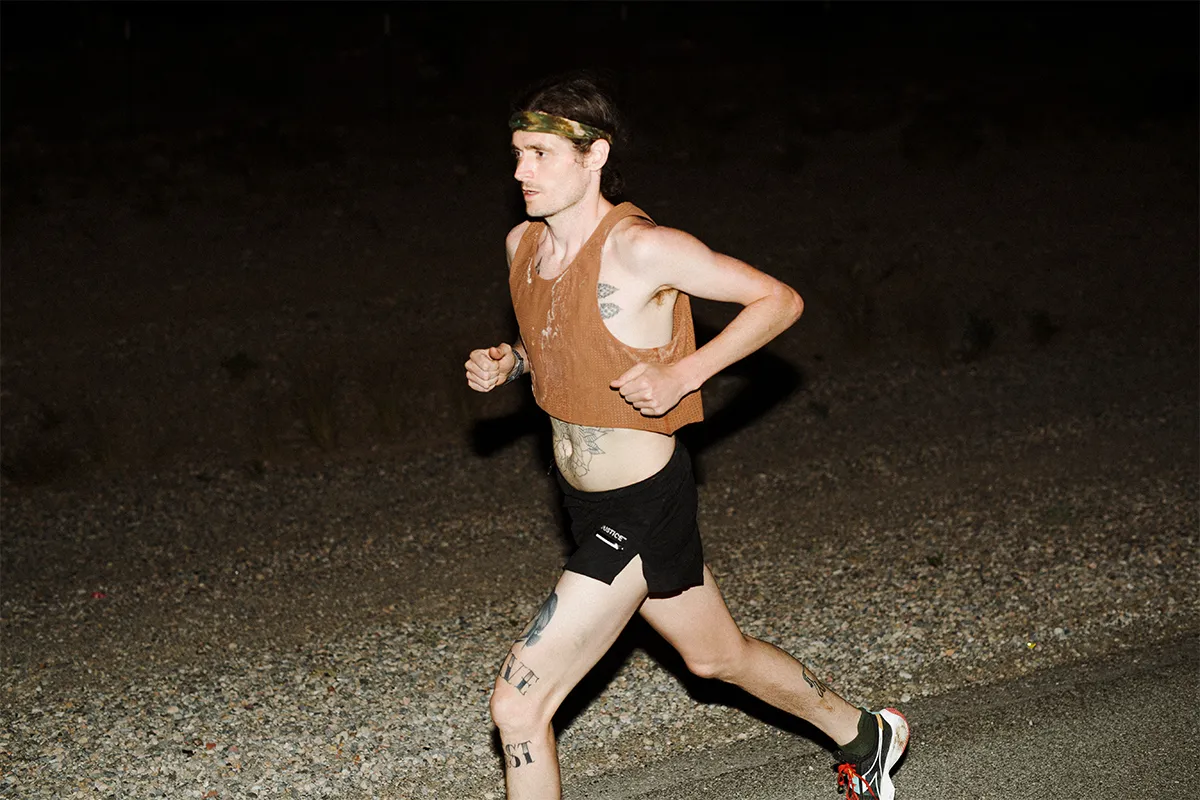
Here’s how they do it: Alex Dickinson and Brad Popple run eight miles each while Remi bikes in front of them holding his iPhone in his left hand with the flashlight on. When Alex isn’t running, Brad is on the other bike. And vice versa. They’ve already run 40 miles since dawn. They haven’t slept. The terrain is messy and unpredictable. There’s no crew to cheer them on, not enough water to make it through the night, no clues — other than the distant road’s waning collection of red taillights — as to when it will all end. Alex describes the experience to me later as a “fever dream spirit walk.” When the traffic finally clears, we shoot past their makeshift midnight caravan, and they have to catch up with the bus. They arrive like soldiers who’ve returned home with a terrible secret, and then collapse amid a pile of leggings and quarter-zips that might as well be 400-thread count sheets. There’s no time to congratulate them, not that they’d acknowledge it. The next trio needs to get going. I’m not present for this round, and it’s genuinely difficult to get people to talk about it later on. Intent on making up for lost time, the RV takes a gamble on a trail road. But it’s the Millennium Falcon flying into the throat of a giant space slug. We get stuck again, and Remi’s Fast and Furious trick doesn’t work this time. The runners get down on their knees and dig the car out, rock by rock, until it’s set free. Even after that episode (during which they had emotionally prepared themselves to walk out of the desert), the road relentlessly jackhammers the tires, sending the runners and crew into the air at least once every half mile for four hours.
On dawn patrol in Death Valley, we pledge to not tell the night crew how our leg is going. A few hours of sleep have tricked Alex and Brad into forgetting their time in the war. Lucie is running her fastest shifts all weekend. Remi and Hakim are blasting DMX, and Nirja has come along to give the runners real-time work on their battered legs. She alternates between using a percussive-therapy device and her forearms. At one point, now firmly part of the running rotation, I ask her to take a look at my calves. She confirms that they’re abnormally tight, but actually discourages me from loosening them up. They’re locked in, literally. They’ll need some serious attention when the day is done, but for now they’re actually helping to propel me forward on the roads. Or, road, singular: we’re on the same one the entire morning, some 50 miles to our end destination of Shoshone, an old mining town with a population of 31 people. Every mile would feel the same if not for the mountains. At last, The Speed Project’s infamous elevation climb (“It’s 13,000 feet to Las Vegas,” people like to say) has arrived. The runners eliminate the hills; they seem particularly keen to take them on, and it’s clear they feel somewhat responsible for not being there during the worst of the night, as if their personal effort suddenly counts less. They want to take as many of the 350 miles for themselves as they can — especially the toughest ones. It isn’t ego or masochism. It’s community.
So when Alex pulls up suddenly, clutching his knee, I’m not surprised that he feels guilty. It’s been aggravated by running on the same side of the road all day, which is sloped to prevent flash floods. The runners tend to privately gush over whichever runner’s on the road, and with Alex, it’s not just his speed, but his form. He’s been making it look easy all day — as has Aric Van Halen (son of Alex, nephew of Eddie), who Hakim nicknames “Float God.” Alex’s running form is similarly beautiful. Economy of motion perfected. Hakim likes to stick his arm into the wind whenever the car drives by Alex and undulate his fingers up and down, waves crashing into the surf. Still, Alex has a track background. His legs aren’t used to ultras. Nirja orders him to sit. If not for the rest of the day, at least for the next couple shifts. It’s a surprise, especially because I was half-expecting Brad to keel over. He’s told me about his issues in the past: after one ultra-marathon, he had to go on dialysis for a month. He nearly lost both his kidneys and died. He also has a curious habit of forgetting to drink water. But he continues on nonetheless, a human metronome.
There is a bizarre lack of urgency, I notice, when we reach the bus and trade places again. Usually, it’s a frenzied hey-and-goodbye, with whichever runner is up next darting down the road right away. You know, a relay. But this time, people are picking up extra supplies at a gas station and taking “showers” with the spigot in the back of the RV. They’ve heard they’re in second place, that first place, a group from Chicago, has already made it to Vegas, aided by the use of ATVs that allowed them to avoid arterial roads entirely. No one is upset by this news — they just raise their eyebrows, impressed. Huh, good idea. A podium finish feels well within reach, though, especially with the way the team has been running on day two. They’re not going to lose this race while waiting for fries and coffees at a McDonald’s in Pahrump, Nevada, they decide. There are certain mental health exercises that feel necessary, that will lighten the load of the almost-100 miles that still remain. Or maybe — and this is just as likely — people are starting to lose it. Make no mistake: they want this. Their bodies are more likely to stop them than their brains. But delirium has arrived, and they can’t remember what their lives felt like before this task. What were their names? Where would they go? What did they like to do? They have a creeping idea that something about this pursuit is out of the ordinary, perhaps even insane. But they brush it off. No sleep till Vegas.
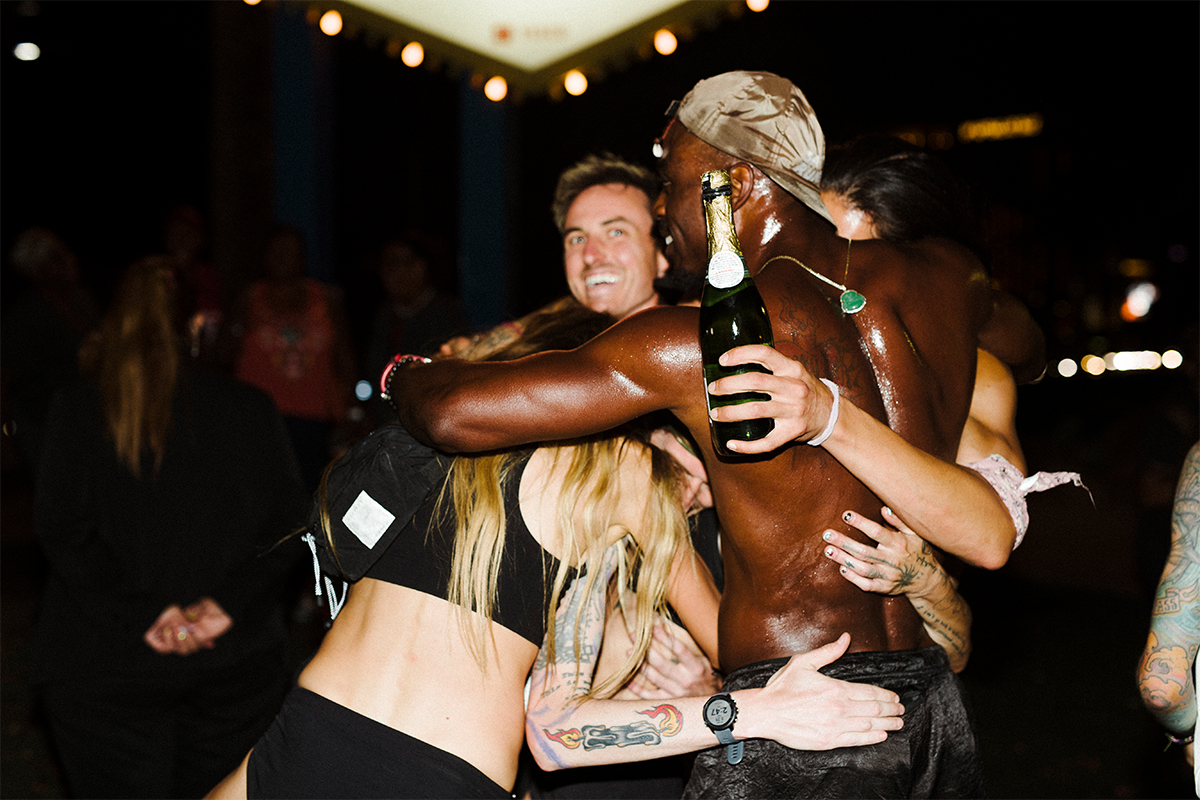
There’s a quote I keep in the Notes app on my phone. I’ve largely relied on it for putting the pandemic into perspective, but I think about it a few times while watching The Speed Project unfold. It’s from Haruki Murakami’s Kafka on the Shore: “And once the storm is over, you won’t remember how you made it through, how you managed to survive. You won’t even be sure, whether the storm is really over. But one thing is certain. When you come out of the storm, you won’t be the same person who walked in. That’s what this storm’s all about.” Written like a true runner: Murakami has finished 27 marathons. Before this storm is over, before the runners celebrate at the finish, doused in neon and four or five bottles of champers, the team discovers a truly shocking piece of information. They’ve run 40 extra miles. During the race, Nils and other Speed Project executives drive around in a limo while wearing tuxedos and gym shorts. They track the location of every team’s RV and often hunt them down to livestream interviews with fatigued runners. They also refresh the standings on Instagram every few hours. The latest list shows Team Satisfy in 12th place. Everyone’s in disbelief. We’ve been cooking all morning. We were in second headed into the day. What went wrong?
Instead of cutting through the Hollow Hills Wilderness Area, a dry lake bajada with fringe-toed lizards that runs east of the road, we had continued northeast along the road — and for far too long. In other words: we spent nearly four extra hours in California. Why didn’t we take a shortcut through the steppe? The primary reason is PTSD from the previous evening’s travails on the trails. The team was eating miles on the cement. The vibes were finally right. Why mess with a good thing? The GPS still had us heading to Las Vegas. Though the original plan — crafted in the weeks and months before the race — had been to maximize power-line trails, the decision to hug the highway was unanimous. Would the alternative have been quicker? Almost certainly. But it should be said, we would’ve been following the Old Spanish Trail, a pack-train trade route discovered in the 1500s, popularized in the Manifest Destiny era and considered one of the most laborious in American history. There’s no guarantee the battered Sprinter would’ve made it out in one piece. Of course, at the time, the runners and crew don’t have time to fully process the pros and cons of miles already run. The life-cycle of this revelation is upsetting and efficient. They face-palm, they curse, they grind their teeth, they grieve their missed chance to show the rest of the race how fast they really are. But they came here to finish, and there is still work to do.
There’s a bend around Mountain Springs, a downhill, where you can see Vegas for the first time. And not just the Stratosphere, but some of the tallest hotels and casinos. It looks defiant at dusk, uncaring of its grim mortality, unaware it will soon run out of water. It shimmers like a mob-town Oz, and it’s funny, because the place has so little to do with these runners. This weird collision was Nils’s vision: plant-eating superfreak athletes descending on a city where most people still smoke indoors. They get giddy when they see it. The whole team, including Alex, is now in the RV, running intervals in lighting succession, as the cockpit drives alongside and takes song requests. The music propels them forward into the city, easing the specter of nightfall, making sure no one feels alone. It’s clear, at this point — regardless of the missed turns, the tweaked knees, the many sunburns — that the plan has worked. Hakim will comment on a Satisfy post two days later: “This is us … Formation complete.” When they make it, they’re looking at each other in awe. It’s more than a runner’s mutual respect or locker-room camaraderie. It’s knowing that they would do anything for each other, and in a way, they already have. There is a mandatory pool party at the Encore Beach Club the next day (because Nils), but they aren’t there for more than a half hour. The day ends with everyone piled in room no. 5256 around trays of room-service pizzas, trying out yoga moves, watching playoff basketball, swapping old hook-up stories and talking about the future of running. Thai has the last word. He points out that no one can take this from them. They will have always done this together.
I wake up around four in the morning. I should’ve left for my flight by now. Down below, a dance floor is throbbing to some calypso-remixed mid-2000s pop song and I imagine the music bouncing off the russet cliffs that guard the city. All my ride-share apps are useless — the whole town is post-gaming — so I wait in the hotel taxi queue with a couple people who look like they’ve lost a lot of money. One man with a wedding band on his finger and three girls on his arm pushes past me to take my car, so by the time I get through security at McCarran International, I’m sprinting to the gate. At one point, I reach a set of stairs and my calves are in absolute disbelief. After all those miles? The nerve. I’m the very last to board. I open up the flight tracker on the screen in front of me. It took us 42 hours to reach Las Vegas. The plane floats to Los Angeles in 42 minutes. From my aisle seat near the bathroom, I can’t see the sunrise, nor the desert, but that’s okay. I’ve had my fill.
Whether you’re looking to get into shape, or just get out of a funk, The Charge has got you covered. Sign up for our new wellness newsletter today.
